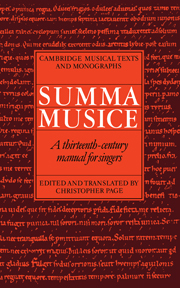Book contents
- Frontmatter
- Contents
- Preface
- Abbreviations
- Intervallic notation in the Summa musice
- 1 The authorship of the treatise
- 2 The scope and character of the treatise
- 3 Sources and metrics
- 4 The text and the edition
- Summa musice: The translation
- Summa musice: The text
- Textual notes and rejected readings
- Sources, parallels, citations and allusions
- Appendix
- Bibliography
- Annotated catalogue of chants
- Index auctorum
3 - Sources and metrics
Published online by Cambridge University Press: 14 January 2010
- Frontmatter
- Contents
- Preface
- Abbreviations
- Intervallic notation in the Summa musice
- 1 The authorship of the treatise
- 2 The scope and character of the treatise
- 3 Sources and metrics
- 4 The text and the edition
- Summa musice: The translation
- Summa musice: The text
- Textual notes and rejected readings
- Sources, parallels, citations and allusions
- Appendix
- Bibliography
- Annotated catalogue of chants
- Index auctorum
Summary
The authors of the Summa musice name all of their main sources except the most important: the De musica by John ‘of Affligem’. As an introduction to the rudiments of chant, to the modes, to the rights and wrongs of chant composition, and finally as a brief compendium of polyphonic practice, the Summa musice owes a significant debt to John's treatise. As the list of sources given below will reveal, this indebtedness sometimes extends to the structure and even to the diction and syntax of some passages. These are relatively few in number, however, for even when they are following John, Perseus and Petrus often add illustrations or remarks of their own. They seem to owe relatively little in precise terms to the other theorists whom they name: principally ‘Odo’, Guido and Hermannus Contractus.
The non-musical sources are many. There are numerous references to Aristotelian treatises available in Latin by c. 1200, for example; those which are identified in the notes to this edition and translation include citations from the Parva naturalia (De sensu et sensibilibus), the Ethica Nicomachea (the books comprising the Ethica vetus), the Topica and the Physica (of which there is a very imperfect recollection at 883). These references point the way which learning was to go in the thirteenth century, but in the Summa musice they stand beside quotations from ancient poets that show the way which learning had come in the twelfth. Some of these were favourites with the grammarians and writers on poetry, and they should give us pause if we are tempted to describe the Summa musiceas a ‘scholastic’ work.
- Type
- Chapter
- Information
- Summa MusiceA Thirteenth-Century Manual for Singers, pp. 33 - 40Publisher: Cambridge University PressPrint publication year: 1991

